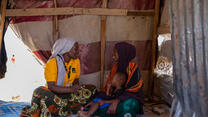In emergency settings, refugees and internally displaced persons (IDPs) often have difficulty accessing key government services, especially if they lack formal documentation of their citizenship or work status. One way of ensuring people are guaranteed their basic rights is to help them access the services to which they are already entitled, by helping them navigate the legal and justice systems. The International Rescue Committee (IRC) operates large-scale case management programs for legal aid in Iraq, working through Protection Assistance and Reintegration Centers (PARCs) spread throughout the country. Just as case management programs for gender-based violence (GBV) survivors or at-risk children conduct needs assessments and provide referrals to necessary services, legal aid caseworkers assess the legal needs of their clients and connect them to the right services.
This analysis examines six legal case management projects in Iraq. Three of these projects were implemented by local partners acting as sub-grantees of the IRC, while three of them were directly implemented by the IRC itself. In addition to learning about the costs of providing such services in insecure environments, examining the cost efficiency of these projects provides an opportunity to assess the assertion that local partners are more cost efficient than large international NGOs (INGOs). The claim that local implementers have leaner cost structures, and access to a larger pool of beneficiaries than international organizations, is explored through this case study of legal protection projects in Iraq.
- The average cost per case over the course of a year ranged between $98 and $1900 in Iraq, with a median cost per case of $400, depending largely on the number of people who used the services. These costs can be thought of relative to the risks that they mitigate. People who lack documentation and legal representation are often unable to move freely, lack physical security and have difficulty securing formal work or accessing government services. They may be deprived of services ranging from health care, food rations, and education, to housing, and social welfare benefits, placing them at increased risk of deprivation or exploitation.
- For directly IRC-implemented legal aid projects, between 40 and 80 percent of total costs went to legal aid staff and supplies; this suggests that incremental costs that increase use of those services could increase the cost efficiency of these projects. A sizeable proportion of spending was dedicated to the staff and spaces which made legal aid available to clients, which is encouraging. Because case management provides a flow of services, rather than a discrete distribution of goods, its cost efficiency can be improved by increasing the number of people using those services—for instance, through awareness raising campaigns which increase the number of vulnerable people seeking assistance.
- Data from this small sample of projects suggests that local partners—who do have lower costs— can operate more cost-efficiently than INGOs, though this may have been due to the fact that local partners worked on different kinds of cases than the IRC. The median cost per case served during 2015 was $138 through the three local partners and $597 for the IRC as a direct implementer. Interestingly, this was not driven by lower support costs, but by lower spending per case on programmatic resources like lawyers. Anecdotal evidence suggests that this may be because local partners focused on providing legal aid to people who required less-intensive services. This suggests that local partners are not a substitute for INGOs, but fill a complementary role by providing a high volume of services on cases that do not require as intensive legal support.
- Legal case management projects often use funding from several grants to provide the whole package of services; if funding across grants is not considered then the cost per case of such services will be mis-estimated. Each of the projects in this analysis was supported by four to five separate grants, and data had to be collated across them to generate an accurate understanding of the costs and outputs in different governorates.



